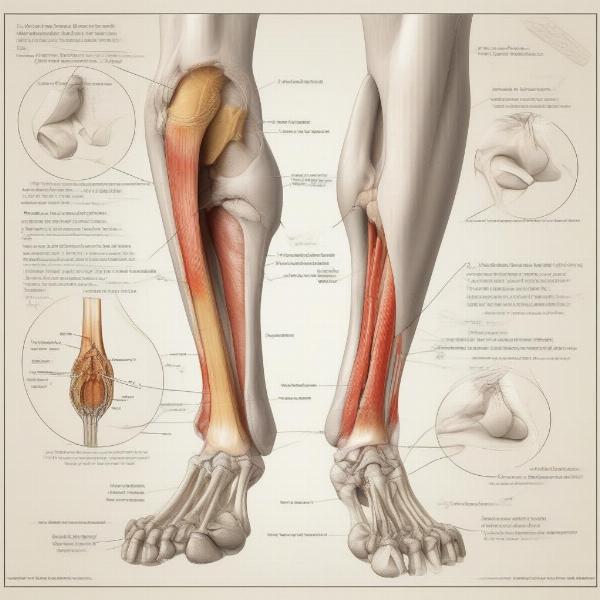The calcaneal tendon, commonly known as the Achilles tendon, plays a vital role in a dog’s ability to walk, run, and jump. This crucial tendon connects the calf muscles to the heel bone (calcaneus), enabling powerful propulsion. Understanding the calcaneal tendon, potential injuries, and treatment options is essential for any dog owner. This article will delve into everything you need to know about calcaneal tendon injuries in dogs, providing valuable insights into causes, symptoms, diagnosis, and management.
Understanding the Calcaneal Tendon in Dogs
The calcaneal tendon is the largest and strongest tendon in a dog’s body. It’s a thick band of fibrous tissue that endures significant stress with every stride. This tendon allows your dog to extend its hock joint, pushing off the ground for movement. Any damage to this tendon can significantly impact a dog’s mobility and quality of life.
 Dog Calcaneal Tendon Anatomy
Dog Calcaneal Tendon Anatomy
Common Causes of Calcaneal Tendon Injuries
Calcaneal tendon injuries can occur due to a variety of reasons, ranging from sudden trauma to gradual wear and tear. Common causes include:
- Traumatic injuries: Sudden, forceful movements, such as jumping from a height or getting the leg caught, can cause tears or ruptures in the tendon.
- Overexertion: Excessive running, jumping, or strenuous activity, especially on uneven terrain, can strain the tendon.
- Degenerative diseases: Conditions like tendonitis (inflammation of the tendon) can weaken the tendon over time, making it more susceptible to injury.
- Deep lacerations: Cuts to the back of the leg can sever the calcaneal tendon.
- Underlying medical conditions: Systemic diseases such as diabetes or Cushing’s disease can weaken connective tissues, including tendons.
Recognizing the Symptoms
If your dog experiences a calcaneal tendon injury, they may exhibit several signs, including:
- Lameness: Often severe, especially immediately after the injury.
- Swelling and pain: Around the heel and lower leg.
- Inability to bear weight: On the affected leg.
- Abnormal gait: A “dropped hock” appearance, where the heel is closer to the ground than usual.
- Pain when the tendon is touched.
Diagnosing Calcaneal Tendon Injuries
If you suspect your dog has a calcaneal tendon injury, seek veterinary attention immediately. The veterinarian will conduct a thorough physical examination, assess the dog’s gait, and palpate the tendon to check for pain, swelling, and any abnormalities. Diagnostic imaging, such as X-rays and ultrasound, may be necessary to confirm the diagnosis and determine the extent of the damage.
Treatment Options
Treatment for calcaneal tendon injuries varies depending on the severity of the injury. Conservative management, such as rest, ice, compression, and pain medication, may be sufficient for mild strains. However, more severe injuries, such as ruptures, often require surgical intervention.
Surgical repair typically involves suturing the torn tendon back together. Post-operative care includes pain management, restricted activity, and physical therapy to help restore strength and function to the leg.
Preventing Calcaneal Tendon Injuries
While not all injuries are preventable, taking certain precautions can minimize the risk:
- Maintain a healthy weight: Excess weight puts extra stress on the tendons.
- Provide regular exercise: But avoid overexertion, especially on hard surfaces.
- Warm-up before strenuous activity: To prepare the muscles and tendons for exercise.
- Ensure a safe environment: Minimize hazards that could cause injury, such as sharp objects or unstable surfaces.
Conclusion
Calcaneal tendon injuries can be debilitating for dogs, but with prompt diagnosis and appropriate treatment, most dogs can recover and regain their mobility. Understanding the causes, symptoms, and treatment options is crucial for every dog owner. By taking preventative measures and seeking veterinary care when necessary, you can help protect your dog from this painful injury.
FAQ
- How long does it take for a calcaneal tendon injury to heal? Healing time varies depending on the severity of the injury and the chosen treatment method. It can range from several weeks for mild strains to several months for surgical repairs.
- Can a dog walk on a ruptured calcaneal tendon? No, a dog with a ruptured calcaneal tendon will likely be unable to bear weight on the affected leg.
- Is surgery always necessary for calcaneal tendon injuries? Not always. Mild strains may respond well to conservative management. However, surgery is often necessary for complete ruptures.
- What is the prognosis for dogs with calcaneal tendon injuries? The prognosis is generally good with appropriate treatment, but complete recovery may take time and patience.
- How can I prevent my dog from re-injuring its calcaneal tendon? Follow your veterinarian’s instructions for post-operative care and rehabilitation. Avoid overexertion and maintain a healthy weight for your dog.
- What are the signs of infection after calcaneal tendon surgery? Increased pain, swelling, redness, discharge, and fever. Contact your vet immediately if these occur.
- What kind of physical therapy is recommended after calcaneal tendon surgery? Controlled leash walks, range of motion exercises, and hydrotherapy. Your vet will guide you on a suitable plan.
ILM Dog, a leading online resource for dog care and well-being, offers expert advice on all aspects of dog ownership, from breed selection and health care to training and nutrition. We strive to provide reliable and practical information to dog owners worldwide. For expert guidance on choosing the right products and accessories for your furry friend, explore our website or contact us directly. Email: [email protected], Phone: +44 20-3965-8624. ILM Dog is committed to helping you provide the best possible care for your canine companion.